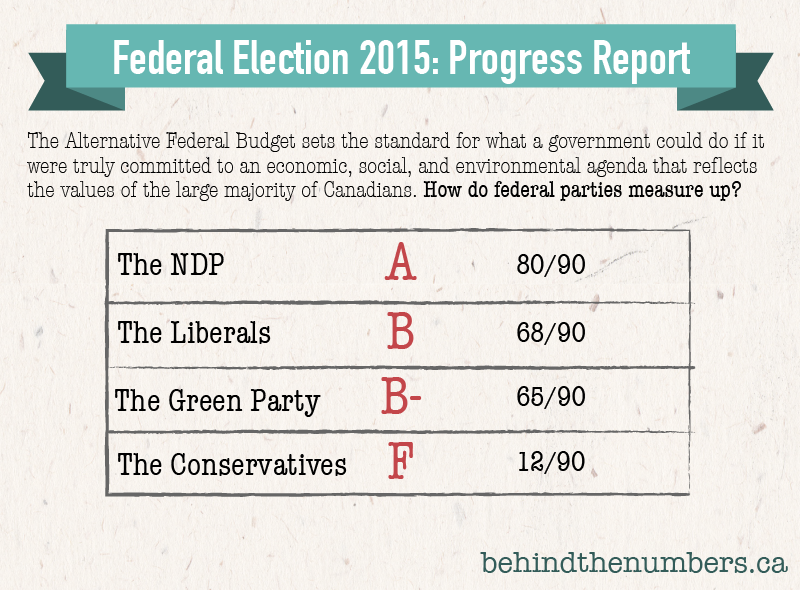All federal election platforms are finally out (Conservatives, NDP, Liberal & Green). The Conservatives have also been running on Budget 2015, which they tabled in the spring. With these documents in hand, we can finally do an in-depth analysis of what the different parties have on offer.
CCPA researchers have done some of this work already here, here, and here, and early in the campaign we released an income inequality platform based on our annual Alternative Federal Budget (AFB). The AFB is coordinated by the CCPA and is the result of collaborative deliberations amongst over a hundred civil society organizations representing millions of Canadians. It shows what the federal government could do if it decided to seriously address Canadians’ largest social, economic, and environmental concerns.
Instead of providing my own opinion on each platform, I grade the platforms based on how much they overlap with the standard of progressive policy: the 2015 Alternative Federal Budget (AFB).
With that in mind, drum roll please….

Here’s how my points system works:
<li>1 point = any overlap with the AFB and the party platform on a single program item</li>
<li>2 points = the platform spends more than half what the AFB proposes for that item</li>
<li>3 points = the platform spends the same or more than the AFB would on that item</li>
Now, there are actually many good ideas in the party platforms that aren’t in the AFB, such as the Green plan to legalize and tax marijuana, or the Liberal and NDP promises to crack down on small business tax loopholes. But if the proposal wasn’t in AFB 2015, these campaign pledges get a score of zero. For the sake of consistency, I only evaluate the overlap between each platform and the AFB.
The scoring includes both revenue and expenditure items. Overlap with each of the AFB’s 90 program lines can earn a maximum score of three (3). Some programs, like a carbon tax, are worth far more money ($22 bil) than others, like an inquiry into missing and murdered Aboriginal women ($10 mil), but still platforms can only get a maximum of three on either, irrespective of their dollar value.
As fully costed as the parties claim their platforms are, we did not want to make this test too difficult, so the scoring is out of 90 points. In other words, if a platform simply mentioned every AFB program item (with some costing) it would earn 90 out of 90, an A+ , based on the current grading scheme at my alma mater, the University of Windsor. Theoretically, based on this scheme, a party could score higher than 90 (if, on enough AFB items, they spent less than half of our proposed funding levels).
Is the above marking scheme somewhat arbitrary? You betcha. But it manages to reduce the complexity of each platform to a single, seemingly value-neutral number, which, as an economist, is deeply satisfying.
If you get excited (like I do) about comparing the actual spending on a year-by-year basis, platform by platform, you can see my spreadsheet here.
David Macdonald is a Senior Economist with the CCPA. Follow David on Twitter @DavidMacCdn.






